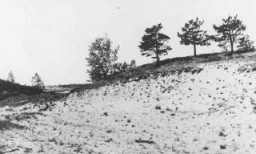You searched for: 5G基站源码搭建定制开发【TG���������@EK7676】平台包网搭建5G基站源码搭建定制开发【TG���������@EK7676】平台包网搭建1GZTwVod8U
<< Previous | Displaying results 101-125 of 820 for "5G基站源码搭建定制开发【TG���������@EK7676】平台包网搭建5G基站源码搭建定制开发【TG���������@EK7676】平台包网搭建1GZTwVod8U" | Next >>
-
Boarding the SS Mouzinho
PhotoJewish refugees board the SS Mouzinho for the voyage to the United States. Among these refugees is a group of Jewish children recently rescued from internment camps in France. Lisbon, Portugal, ca. June 10, 1941.
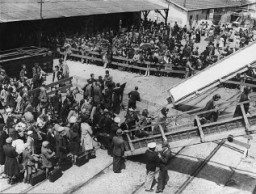
-
Ruins of the Warsaw ghetto
PhotoA view of the wall surrounding the ruins of the Warsaw ghetto in German-occupied Poland a few months after the ghetto's destruction. Photograph taken ca. June-October 1943.
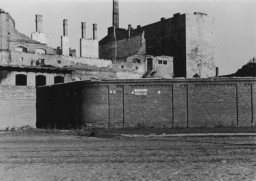
-
Gregor Wohlfahrt
ID CardGregor was the second of six children born to Catholic parents in a village in the part of Austria known as Carinthia. His father was a farmer and quarryman. Disillusioned with Catholicism, his parents became Jehovah's Witnesses and raised their children according to that religion. As a boy, Gregor loved mountain climbing and skiing. 1933-39: Gregor attended school and worked as a waiter. The situation for Jehovah's Witnesses worsened after Germany annexed Austria in March 1938; Witnesses refused to swear…
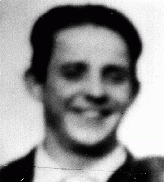
-
Permit for stay in Japan
DocumentJapanese authorities issued this "Permit for stay in Japan" to Ruth Segal (Rys Berkowicz). After several unsuccessful attempts to obtain visas for the United States, Ruth's father was able to secure a visa for her to go to New Zealand, in the British Commonwealth of Nations. [From the USHMM special exhibition Flight and Rescue.]
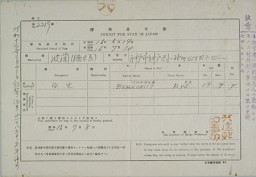
-
Census Card
DocumentOn December 17, 1941, the Romanian government issued a decree requiring a census of all those with “Jewish blood.” All persons having one or two Jewish parents or two Jewish grandparents were ordered to register at the Central Jewish Office. This is a census certificate issued by that office in 1942.
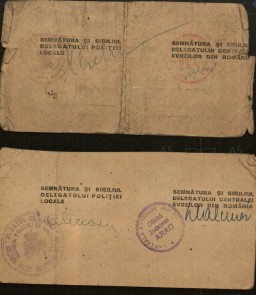
-
Auschwitz - ID Card/Oral History
Media EssayThe Auschwiz camp complex was the largest of its kind established by the Nazi regime. Auschwitz consisted of three main camps, including a killing center. More than 1.1 million people were murdered at Auschwitz. Individuals not sent directly to th...
-
Evidence Tag
ArtifactEvidence tag from the trial of Klaus Barbie in Lyon, France. This standard police form lists Barbie's infractions as crimes against humanity and complicity, concepts defined at the International Military Tribunal at Nuremberg decades earlier. The line in which the victims' names would be recorded is left blank. February 25, 1983.

-
Liberation of Bergen-Belsen
FilmAfter British soldiers liberated the Bergen-Belsen concentration camp in Germany, they forced the remaining SS guards to help bury the dead. Here, survivors of the camp taunt their former tormentors, who prepare to bury victims in a mass grave.
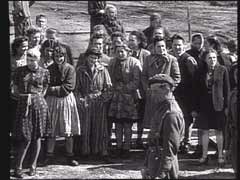
-
Liberation of Mauthausen
FilmThe Mauthausen concentration camp was established shortly after the German annexation of Austria (1938). Prisoners in the camp were forced to perform crushing labor in a nearby stone quarry and, later, to construct subterranean tunnels for rocket assembly factories. US forces liberated the camp in May 1945. In this footage, starving survivors of the Mauthausen concentration camp eat soup and scramble for potatoes.
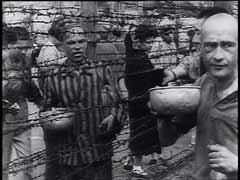
-
Conditions in the Warsaw ghetto
FilmThe Nazis sealed the Warsaw ghetto in mid-November 1940. German-induced overcrowding and food shortages led to an extremely high mortality rate in the ghetto. Almost 30 percent of the population of Warsaw was packed into 2.4 percent of the city's area. The Germans set a food ration for Jews at just 181 calories a day. By August 1941, more than 5,000 people a month succumbed to starvation and disease.
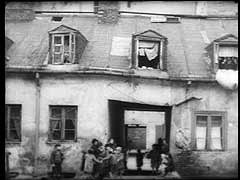
-
Defendant Julius Streicher
PhotoDefendant Julius Streicher in his prison cell at Nuremberg. For his influential role in inciting hatred and violence, the International Military Tribunal at Nuremberg indicated Streicher on count four, crimes against humanity. Streicher was found guilty and sentenced to death. He was hanged on October 16, 1946.

-
Ernest Hemingway
PhotoPortrait of Ernest Hemingway by Helen Pierce Breaker. Paris, France, ca. 1928. In 1933, Nazi students at more than 30 German universities pillaged libraries in search of books they considered to be "un-German." Among the literary and political writings they threw into the flames were the works of Ernest Hemingway.
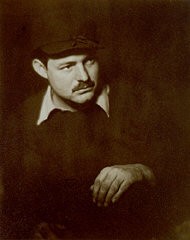
-
Rescue and Resistance during the Holocaust
SeriesDespite the inaction of most Europeans and the collaboration of many in the persecution and murder of Jews, some individuals and networks from all social and religious backgrounds aided Jews. Learn more.
-
Annexation of Austria: The Anschluss
FilmIn an attempt to prevent the German annexation of Austria, Austrian chancellor Kurt von Schuschnigg called a plebiscite (referendum) on Austrian independence. On March 11, 1938, the Germans pressured Schuschnigg to cancel the plebiscite and resign. This German newsreel footage from March and April 1938 served as propaganda for the Nazi annexation of Austria. It begins with images of pro-Nazi residents in Graz expressing their opposition to Schuschnigg's plebiscite. It also includes footage after…
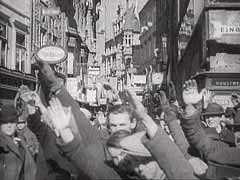
-
Abraham Klausner describes encountering survivors of the Dachau camp
Oral HistoryRabbi Abraham Klausner was a US Army military chaplain. He arrived in the Dachau concentration camp in May 1945. He was attached to the 116th evacuation hospital unit and worked for about five years in displaced persons camps, assisting Jewish survivors.
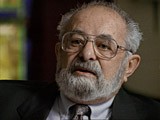
-
Abraham Lewent describes the moments following his liberation from a death march from the Dachau camp
Oral HistoryLike many other Jews, the Lewents were confined to the Warsaw ghetto. In 1942, as Abraham hid in a crawl space, the Germans seized his mother and sisters in a raid. They perished. He was deployed for forced labor nearby, but escaped to return to his father in the ghetto. In 1943, the two were deported to Majdanek, where Abraham's father died. Abraham later was sent to Skarzysko, Buchenwald, Schlieben, Bisingen, and Dachau. US troops liberated Abraham as the Germans evacuated prisoners.
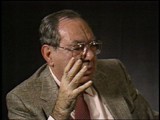
-

-
Mass grave at Bergen-Belsen
PhotoAfter camp liberation, one of the mass graves at the Bergen-Belsen camp. Germany, after April 15, 1945.
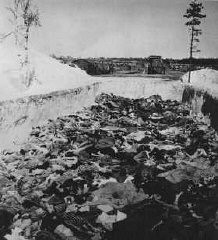
-
Deportation from the Warsaw ghetto
PhotoJews from the Warsaw ghetto are marched through the ghetto during deportation. Warsaw, Poland, 1942–43.
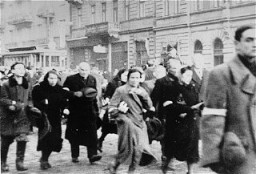
-
Street scene in the Warsaw ghetto
PhotoStall of a street vendor selling old Hebrew books. Warsaw ghetto, Poland, February 1941.

-
Reich Party Day parade
PhotoSpectators cheer passing SA formations during a Reichsparteitag (Reich Party Day) parade in Nuremberg.
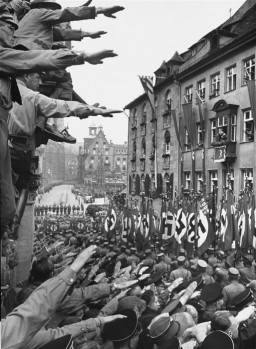
-
Palace of Justice Entry Pass
ArtifactBack side of an entry pass to the court building at the International Military Tribunal. This pass was issued to a U.S. military guard. The pass is printed in each of the IMT's four official languages.
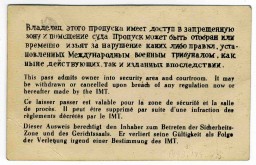
-
Edward Vebell courtroom sketch
ArtifactCourtroom sketch drawn during the International Military Tribunal by American artist Edward Vebell. The drawing's title is "British Courier for the Correspondents." 1945.
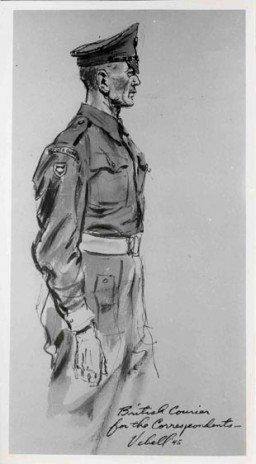
-
Home vandalized during Kristallnacht
PhotoA private Jewish home vandalized during Kristallnacht (the "Night of Broken Glass" pogrom). Vienna, Austria, November 10, 1938.
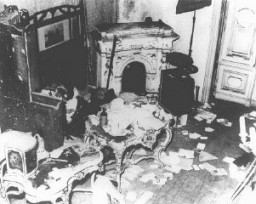
-
Mass execution site in Estonia
PhotoSite where members of Einsatzgruppe A and Estonian collaborators carried out a mass execution of Jews in September 1941. Kalevi-Liiva, Estonia, after September 1944.
